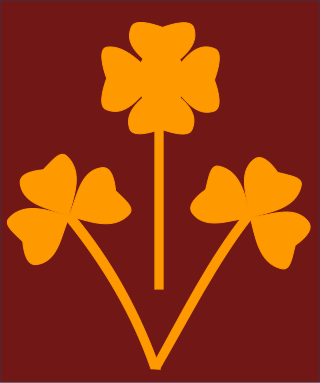
The 4th Indian Infantry Division, also known as the Red Eagle Division, is an infantry division of the Indian Army. This division of the British Indian Army was formed in Egypt in 1939 during the Second World War. During the Second World War, it took part in campaigns in East Africa, Syria, North Africa and Italy. Post independence, the division is part of the I Corps and headquartered at Prayagraj.

The South African 3rd Infantry Division was an infantry division of the South African Army during World War II.

The 5th Indian Infantry Division was an infantry division of the Indian Army during World War II that fought in several theatres of war and was nicknamed the "Ball of Fire". It was one of the few Allied divisions to fight against three different armies - the Italian, German and Japanese armies.

The 8th Mountain Division was raised as the 7th Indian Infantry division of the British Indian Army. It is now part of the Indian Army and specialises in mountain warfare.

The 29th Infantry Brigade was an infantry brigade unit of the British Army. It was originally raised in 1914 and saw service during the First and Second World Wars and the Korean War.
The 7th Indian Infantry Brigade was an infantry brigade of the Indian Army during World War II. It was formed in September 1939, by the redesignation of the Poona Independent Brigade as the 7th Indian Infantry Brigade and renumbered 4th in June 1940, A second 7th Brigade was formed in June 1940, and assigned to the 5th Indian Infantry Division. In September 1940, it was reassigned to the 4th Indian Infantry Division. The brigade formed the garrison at Mersa Matruh in early December 1940. In January 1941, with the rest of the 4th Indian Division were sent to fight in the Sudan campaign.
The 11th Indian Infantry Brigade was an infantry brigade formation of the Indian Army during World War II. It was relocated from India to Egypt in the middle of August 1939 and trained at Fayed in Ismailia Governorate on the Great Bitter Lake. In October 1939, it was assigned to the 4th Indian Infantry Division. In May 1942, it was attached to the 5th Indian Infantry Division and in June the 2nd South African Infantry Division when it surrendered after Tobruk was captured by the Germans and Italians in 1942. The brigade was then reformed in Egypt in October 1943 and once more assigned to the 4th Indian Division serving in Tunisia, Italy and, at the end of the war, in Greece.
The 17th Indian Infantry Brigade was an infantry brigade formation of the Indian Army during World War II.

The Royal Hungarian Army was the name given to the land forces of the Kingdom of Hungary in the period from 1922 to 1945. Its name was inherited from the Royal Hungarian Honvéd which went under the same Hungarian title of Magyar Királyi Honvédség from 1867 to 1918. Initially restricted by the Treaty of Trianon to 35,000 men, the army was steadily upgraded during the 1930s and fought on the side of the Axis powers during World War II.
The 1st Motorised Brigade was a formation of the Royal Hungarian Army that participated in the Axis invasion of Yugoslavia during World War II.
The 2nd Motorised Brigade was a formation of the Royal Hungarian Army that participated in the Axis invasion of Yugoslavia during World War II.
The 10th Infantry Brigade was a formation of the Royal Hungarian Army that participated in the Axis invasion of Yugoslavia during World War II.
The 12th Infantry Brigade was a formation of the Royal Hungarian Army that participated in the Axis invasion of Yugoslavia during World War II.
The 14th Infantry Brigade was a formation of the Royal Hungarian Army that participated in the Axis invasion of Yugoslavia during World War II.
The IV Corps was a corps-level formation of the Royal Hungarian Army which saw extensive action on the Eastern Front during World War II.
The V Corps was a formation of the Royal Hungarian Army.
The I Corps was a formation of the Royal Hungarian Army that participated in the Axis invasion of Yugoslavia during World War II.
The 13th Infantry Brigade was a formation of the Royal Hungarian Army that participated in the Axis invasion of Yugoslavia during World War II.
The 15th Infantry Brigade was a formation of the Royal Hungarian Army that participated in the Axis invasion of Yugoslavia during World War II.
The 19th Infantry Brigade was a formation of the Royal Hungarian Army that participated in the Axis invasion of Yugoslavia during World War II.





